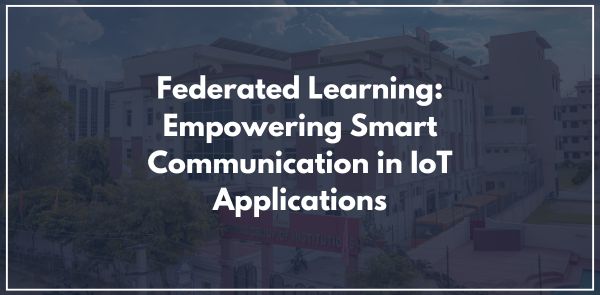The proliferation of Internet of Things (IoT) devices has ushered in an era of unprecedented data generation. However, centralizing and processing this vast amount of data poses significant challenges, particularly concerning privacy, security, and bandwidth limitations. Federated learning (FL) emerges as a promising solution, enabling distributed machine learning without compromising data privacy. In the context of smart communication, FL leverages the decentralized nature of IoT to enhance intelligence and efficiency.
One of the best colleges in Jaipur, Poddar International College, offers exceptional development through experiential learning and practical exposure as part of its Curriculum-Internet of Things (IoT). The college addresses the social implications of IoT so as to prepare students for challenges in the areas of ethics, security, and connectivity, while presenting excellent placement opportunities in the technical domain.
The Challenge of Centralized Learning in IoT
Traditional machine learning approaches require aggregating data from all devices to a central server for training. This presents several critical issues in IoT applications:
- Privacy Concerns: Sensitive data collected by IoT devices, such as health records, location information, and personal preferences, is exposed during transmission and storage.
- Bandwidth Limitations: Transmitting massive datasets from numerous IoT devices to a central server can strain network bandwidth and increase latency, particularly in resource-constrained environments.
- Security Risks: Centralized storage creates a single point of failure, making the system vulnerable to cyberattacks and data breaches.
Federated Learning: A Decentralized Approach
Federated learning addresses these challenges by training machine learning models directly on the edge devices, without requiring data to be transferred to a central server. The process involves the following steps:
- Local Training: Each IoT device trains a local model using its own data.
- Model Aggregation: The locally trained models are sent to a central server, where they are aggregated to create a global model.
- Global Model Distribution: The global model is then distributed back to the IoT devices for further local training or inference.
This iterative process enables the global model to learn from the collective intelligence of all devices while preserving data privacy.
Benefits of Federated Learning in Smart Communication
FL offers several advantages for smart communication in IoT applications:
- Enhanced Privacy: Data remains on the edge devices, minimizing the risk of privacy breaches.
- Reduced Bandwidth Consumption: Only model updates, not raw data, are transmitted, significantly reducing bandwidth requirements.
- Improved Security: Distributed data storage reduces the risk of centralized attacks.
- Increased Efficiency: Local training and inference reduce latency and improve real-time performance.
- Personalization: FL allows for personalized models tailored to the specific needs of individual users.
- Resilience: The distribution of the model makes the system more resilient to device failures.
Applications in Smart Communication
FL can be applied to various smart communication scenarios within IoT:
- Smart Homes: FL can be used to train personalized models for home automation systems, such as smart lighting, thermostats, and security systems, without compromising user privacy.
- Smart Cities: FL can enable real-time traffic management, pollution monitoring, and energy optimization by training models on data collected from distributed sensors and devices.
- Industrial IoT (IIoT): FL can be used for predictive maintenance, anomaly detection, and process optimization in industrial settings, improving efficiency and reducing downtime.
- Healthcare IoT: FL can enable remote patient monitoring and personalized healthcare services while protecting sensitive medical data.
- Autonomous Vehicles: FL can be used to train models for autonomous driving, enabling vehicles to learn from each other's experiences without sharing raw data.
Challenges and Future Directions
Despite its advantages, FL faces several challenges:
- Communication Overhead: Model aggregation and distribution can still consume significant bandwidth, especially in large-scale deployments.
- Heterogeneity of Devices: IoT devices have diverse hardware and software capabilities, making it challenging to train and aggregate models effectively.
- Data Heterogeneity: Data collected by different IoT devices can vary significantly in quality and distribution, affecting model performance.
- Security Vulnerabilities: While FL enhances privacy, it is still vulnerable to attacks, such as model poisoning and inference attacks.
- Coordination and Synchronization: Maintaining synchronization and coordination among numerous distributed devices can be complex.
Future research directions include developing efficient communication protocols, addressing data heterogeneity, enhancing security, and optimizing model aggregation techniques. As FL matures, it will play a crucial role in enabling secure, efficient, and intelligent smart communication in the ever-expanding world of IoT.
